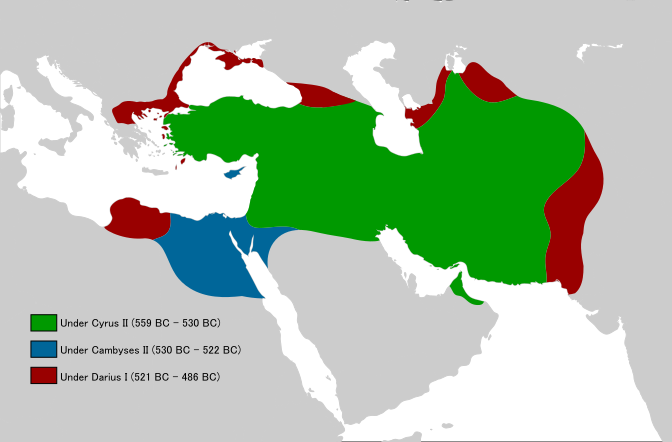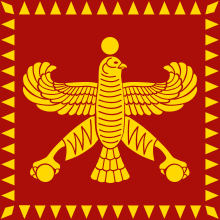Accomplishments Of Cyrus The Great

Cyrus the Nifty – biography and achievements
Cyrus the Great, also known as Cyrus II, is famed as the founding-emperor of the Achaemenid Empire (likewise known equally the Persian Empire). An astute military genius and statesman, Cyrus'south ascension to acclaim began after he conquered the Median Empire, Lydia and some parts of Anatolia. Kind courtesy to his well-crafted armed forces conquests, he defeated many tearing nomadic tribes in nowadays-day eastern Islamic republic of iran.
At the elevation of his power, Cyrus the Great ruled over the largest empire to ever exist at the time. Under his rule, the Western farsi Empire stretched from nowadays-twenty-four hour period Iran to places in present-twenty-four hour period Turkey. This gave him access to major ocean ports of the Mediterranean Sea.
For a ruler in antiquity, Cyrus' bravery, leadership style and tolerance for diversity certainly sets him apart from his contemporaries. It comes as no surprise that Greek historians Herodotus and Xenophon heaped enormous praises on the Persian ruler.
What other feats was Cyrus the Great most known for? Beneath, World History Edu delves into the diverse military conquests, diplomatic moves, and major accomplishments of Cyrus the Great, the founder of the Achaemenian Empire.
Built Pasargadae as the first capital of the Farsi Empire
Located in modern day Fars Province, Iran, Pasargadae was once a humming and thriving Persian city which served as the political hub during Cyrus the Swell'due south reign. Cyrus is credited with building Pasargadae around the half-dozenth century BC. Following his conquest of Media, Cyrus elevated the city to capital city status. The city was said to have been built near the site where he secured victory over King Astyages of Media in 550 BC. The tomb of Cyrus the Great, which was fabricated to await similar a Mesopotamian/Elamite ziggurat, is situated in Pasargadae. Archaeologists have also unearthed the royal tombs of Cyrus' son and successor Cambyses Ii.
Pasargadae remained the capital city of the Achaemenid Empire for many years later on the death of Cyrus until Persian Rex Darius the Great moved the capital letter to Persepolis (present twenty-four hour period Fars Province, Iran).
Today, the ruins of the metropolis Pasargadae, which is nearly 90 kilometers (56 miles) to the northeast of the urban center of Shiraz in Islamic republic of iran, are considered one of the UNESCO Globe Heritage sites in Islamic republic of iran.

Following his decease in 530 BC, Cyrus was succeeded past his eldest son and crown prince Cambyses 2 (r. 525-522 BC). Cyrus died during a armed forces campaign against Eastern Iranian nomadic group of tribes in Key Asia. | Image: Cyrus the Great with a Hemhem crown, or four-winged Cherub tutelary divinity, from a relief in the residence of Cyrus in Pasagardae
Defeated King Croesus of Lydia in Asia Minor
Following the capitulation of Medes to Cyrus's growing Persian kingdom, a number of tribes and kingdoms, including Lydia in Asia Pocket-sized, started eating into territories that were in one case part of Medes. Cyrus the Swell could non allow that happen. Beginning around 548 BC, the Persian rex started moving against those areas. He struck the eye of Lydia, i.e. the city of Sardis, with all his might. Past 546, the Lydian capital had surrendered to Cyrus's Persian army, killing Male monarch Croesus in the procedure. Some accounts say that Cyrus burnt the Lydian male monarch to death. According to an account by Herodotus, Cyrus took Croesus prisoner and later made him a member of his courtroom.
Benefited tremendously from major sea ports on the Mediterranean Bounding main
With Lydia firmly nether his control, Cyrus was also in charge of many vassals states that were under the Lydian rulers. This gave him admission to many port cities on the Aegean Sea declension. Cyrus was swift in burdensome every semblance of defection in Ionian Greek cities that failed to tow his line. The Farsi king was able to rake in a lot of revenue due to his control of major sea ports on the Mediterranean.
Conquered ancient Babylonia in 539 BC
Another important armed forces conquest of Cyrus the Bully came when he marched against the Neo-Babylonian Empire. The ancient Mesopotamian city of Babylonia, a city which once had mighty rulers similar Hammurabi, was at that place for taking every bit it had fallen into years of poor leadership. It'south been said that the inhabitants of Babylonia prayed for the twenty-four hour period Cyrus would conquer the city and go rid of the inept rulers like Nabonidus and his son Belshazzar. Therefore Cyrus's conquest of Babylonia in 539 BC was more or less liberation of Babylonia. The conquest of Babylon also meant that the Persian Empire inherited a number of Babylonian territories in Palestine and Syria.
Restored the worship of the Babylonian god Marduk

Marduk – 9th century BC depiction of the Statue of Marduk, with his servant dragon Mušḫuššu. This was Marduk's main cult image in Babylon
Known for his liberal philosophies, which was unusual for an ancient ruler, Cyrus was praised for not imposing Persian religious beliefs on the Babylonians, instead he allowed worship of the urban center'due south traditional deities like patron Babylonian god Marduk to flourish. Prior Cyrus's conquest of Babylonia, estranged rulers similar Nabonidus were addicted of suppressing the worship of Marduk, a powerful and revered national deity of Babylon. Therefore, it makes perfect sense when some historical accounts claim that the city's inhabitants were delighted when they saw Cyrus's Persian army march on their urban center. And in some cases, Cyrus the Great was even seen in similar way as the famous Assyrian rex Ashurbanipal. In return for the trust the people had in him, Cyrus is said to accept participated in some of the local customs, even offering sacrifices to many Babylonian deities.
Read more: Well-nigh Famous Gods of Aboriginal Mesopotamia
Cyrus the Keen came to the rescue of persecuted Jews in Babylonia
Many historical accounts heap enormous praise on Cyrus the Cracking for his bold decision to liberate the Jews in the urban center of Babylon. For many centuries, Jewish communities in Babylonia were treated as second form citizens, mostly persecuted disproportionately for their religious beliefs. Following his conquest of Babylonia in 539 BC, Cyrus freed the Jews, allowing many of them to return to their abode in Jerusalem. This feat of his was recorded in the Cyrus Cylinder – an ancient clay cylinder with Akkadian cuneiform script – as well the Bible.
The Jews had been defeated past Babylonian rex Nebuchadnezzar Ii, after the Babylonian army besieged Jerusalem during the Jewish-Babylonian State of war (601-586 BC). Major Jewish cities and towns were destroyed, likewise Solomon's Temple in Jerusalem. Following the defeat, the Babylonian king took many Jews every bit slaves back to the city of Babylon, where they were kept in chains until the arrival of Cyrus the Swell in the mid-sixth century BC.
Cyrus the Nifty's liberation of the Jews in aboriginal Babylon is mentioned in the Hebrew Bible, in Isaiah 45:ane. The scriptures even state that God blessed Cyrus, describing the Persian ruler as the 'all-powerful one'. Cyrus thus holds the honor of beingness the only non-Jewish figure in the Bible to have that distinguished title. Accounts of Cyrus' saving the Jews tin can also be found in the Biblical volume of Ezra.

Cyrus the Smashing
Instituted a policy of religious liberty in the places he conquered
According to a number of historical accounts, Cyrus the Great avoided imposing his Western farsi culture and religious beliefs on the conquered people of Babylonia. The Persian ruler ordered his representatives to be respectful to the local customs and protect the religious monuments and structures in those conquered territories. Every bit a result, the locals, rather than run into Cyrus as a tyrant, came to adore him as benevolent leader who protected the social construction of the people.
He was open to diplomacy when the need arose
Cyrus was not only known for his numerous military conquests of areas in the Mesopotamian region, but he was besides known for being a competent diplomat. At times, he put to use his apt skills in diplomacy to strike peace ties with many rulers in the region. One such famous peace tie came with the ruler of Cilicia in Asia Minor (Asian portion of present day Turkey). Cilicia was a strategic region in the ancient world as it served as the major route from Anatolia to Syria. Fully aware of this strategic reward, Cyrus thought information technology wise that information technology served his interest better to accept a cordial relationship with the inhabitants of Cilicia than a frosty one.
Read More:10 Greatest Ancient Mesopotamian Kings
Many ancient cities flourished during his rule
During the reign of Cyrus the Swell, many cities rose to prominence, not simply in Mesopotamia, but around the known world at the time. Possibly the most famous city in the empire at the fourth dimension was the capital city Pasargadae in Persis. Ecbatana (modern day Hamadan in Iran) in Media, Susa (modernistic Shush, Khuzestan Province, Iran), and Babylon (mod day Iraq) were also famous during the reign of Cyrus. The latter city served as the wintertime upper-case letter of Cyrus the Nifty.

In 539 BC, Cyrus the Great incorporated the ancient city of Babylon into his vast and always growing Persian Empire. At the time, Babylon was indeed the greatest city in the globe equally it was the eye of art, science, learning and commerce. | Image: Achaemenid Empire under different kings
A big admirer of diversity in his empire
Cyrus was anything but a civilization and religious chauvinist. He is famed for protecting the places he conquered from too much influence of the Persian culture. He is also praised for learning their customs so as to better understand and rule them. Take the case of Media, a kingdom he conquered in 550 BC, historians country that he seamlessly prevented the Median culture from clashing with the Persian civilisation. To do this he employed a Mede to the position of chief advisor to the king. He also invited many educated and skilled artisans, teachers, physicians and writers from Media into his courtroom. Cyrus' goal was to create a united and heterogeneously diverse empire. Out of those efforts of his, a mighty and culturally rich empire could form.
Read More: Greatest Ancient Military Commanders
Cyrus the Great: Fast Facts

Aboriginal Persia – Standard of Cyrus the Great, founder and first emperor of the Achaemenid Empire, featuring the Shahbaz
Cyrus formed an empire that spanned from the Mediterranean Sea in the west to the Indus River in the eastward. At that size, Cyrus' Persian Empire was undoubtedly the largest in the world had ever seen up until that fourth dimension. His successors, including Cambyses I and Darius the Bang-up, followed in his footstep and grew the Achaemenid Empire to reach places in the Balkans and even southeast Europe.
Born: c. 590 BC or 580 BC
Place of nascency: Media (in today'southward Islamic republic of iran)
Died: c. 529 BC
Place of death: Syr Darya, Central Asia
Burial: Pasargadae (modern day Islamic republic of iran)
Parents: Cambyses I and Mandane of Media
Children: Cambyses II, Bardiya, Atossa
Most known for: Founding the Achaemenian Empire
House: Achaemenian dynasty
Reign: 559-530 BC
Notable battles fought in: Persian Defection, Battle of Hyrba (552), Boxing of Persian Border, Siege of Sardis, Boxing of Opis (539), Battle of Thymbra, Battle of Pteria (547),
Successor: Cambyses II
Other names: Cyrus II, Cyrus II of Persia, Cyrus the Elderberry
Epithets and famous titles: King of Anshan, King of Persia, Male monarch of Media, King of the World, Great Rex, Mighty Male monarch, Rex of Babylon, King of the Four Corners of the Globe
Accomplishments Of Cyrus The Great,
Source: https://www.worldhistoryedu.com/cyrus-the-great-10-major-accomplishments/
Posted by: bowennack1994.blogspot.com


0 Response to "Accomplishments Of Cyrus The Great"
Post a Comment